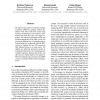877 search results - page 71 / 176 » Complex networks and human language |
103
click to vote
VL
1994
IEEE
15 years 4 months ago
1994
IEEE
The notion of icons in visual environments is limited by perceiving icons as tacit entities that have meaning only to human beings and not to the machines that display them. This ...
101
click to vote
TSD
2009
Springer
15 years 6 months ago
2009
Springer
Abstract. One of the most amazing characteristics that defines the human being is humour. Its analysis implies a set of subjective and fuzzy factors, such as the linguistic, psych...
100
click to vote
GECCO
2005
Springer
15 years 5 months ago
2005
Springer
The Push programming language was developed for use in genetic and evolutionary computation systems, as the representation within which evolving programs are expressed. It has bee...
101
click to vote
HAPTICS
2003
IEEE
15 years 5 months ago
2003
IEEE
As haptic technology becomes more developed, the potential applications for three-dimensional haptic content online become more and more numerous. However, the proliferation of su...
ACL
2008
15 years 1 months ago
2008
We improve the quality of statistical machine translation (SMT) by applying models that predict word forms from their stems using extensive morphological and syntactic information...

